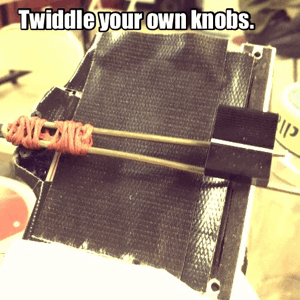The following work by Matthew Hebert (posted below) relates to a discussion Adam, Dakotah, Rob and I had regarding where art belongs…. I think we decided that, eventually, inevitably, it seems to always end up, as all life does, buried in a land pit somewhere. Personally, I don’t mind if stuff I make ends up in the garbage. But I don’t really want to get into a discussion about whether art is “wasteful” or not, or whether it should be “useful” or not.
Instead, let’s just check out this project that might excite Adam, since it combines robotics with design & “utilitarian” shit for your home… you know, furniture.
^ This table is kind of “whimsical” (in a when-robotics-hits-Crate-&-Barrel sort of way?). But the designer is obviously a theory dork (<- no negative connotation), since here we see one of Braitenberg’s vehicles! Maybe 2a style, mentioned on p.6? Though you might not be able to tell from this not very revealing video, these little robots, imprisoned between two sheets of glass, move in the sun, and stay still in the “shade.” Their motors are most likely attached to light sensors. This creates a nice effect when you put something down on the coffee table, since they will flock to it and hide under it. Would I put this in my home if someone gave it to me? Sure. (But as Bob Bingham would ask, “Is it art yet?”)
Here’s another piece based on simple Braiteneberg architectures: a bench that moves itself into the sun (using light sensors in the front, back, and on both sides, as well as a microcontroller). These benches have solar panels on their seats that charge their battery (except, I guess, when someone’s sitting on one…hmmm….) Watch out, this video is rather lengthy.
[Do we always have to use that Strauss composition from 2001 when introducing a monolithic design?][yes]
Coming from the “art” perspective: I think these projects could be more interesting if they complicated the nature of braitenberg architectures, perhaps simultaneously complicating the notion of utilitarian furniture. What if these devices were structured not to be useful? If this furniture made use of slightly extended models of braitenbergian forms (see the Lambrinos / Scheier article)… the emergent behaviors might appear more complex. This could get really weird and interesting, if we’re talking about furniture that is reacting to human use. Incorporating “artificial” learning, or the type of seemingly socially intelligent behaviors discussed in the article we read about folk-psychology might turn a table or a chair into something we really have to think about interacting with…. Heidegger would go bananas.
And last, this Hebert guy takes a stab at “art” !!
After all, if there’s one way to be SURE you’re making art …. it’s by putting it in a museum!
This apparently was a commission from the San Diego Museum of Art in 2011 for a weekly series themed around the topic of “what a city needs.” Here, Hebert says he is approaching this theme “from an interest in power infrastructure and it’s critical importance to the city,” in relation to the often geographical remoteness of most of those forms of power. (Which apparently is especially true in San Diego). Hebert took public domain models from the Google SketchUp library, 3D printed them in ABS plastic, wired electronics to them, and placed them in the museum in what we MIGHT call “non-traditional” locations. Sounds like a well-followed recipe right out o’ the ol’ “art” cookbook to me!



